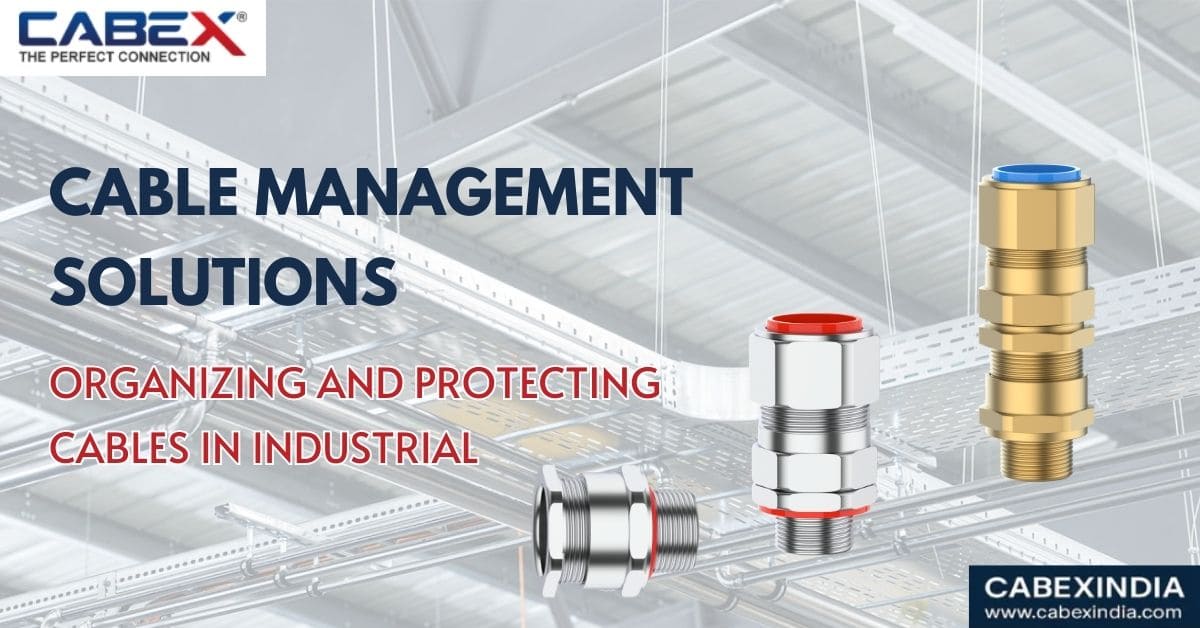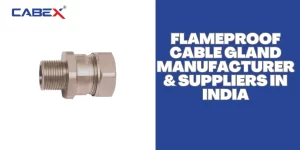Introduction
In 2025, rapid expansion in industrial automation, infrastructure, and data-driven operations has elevated the importance of reliable Cable management systems. Globally, the cable management market is projected to reach USD 17.87 billion in 2025, driven by stringent standards, evolving technologies, and safety regulations. For procurement officers, electrical engineers, safety managers, and contractors across India, the Middle East, and Europe, the selection of Cable glands, accessories, and connectors isn’t just a technical decision—it’s central to operational safety and compliance.
Market Overview & Trends
Cable management is evolving with growing data centers, smart factories, and energy projects. Key drivers include:
- Growth & Demand: The Indian cable management market alone is expected to reach USD 1.64 billion by 2033. Globally, industries are accelerating at a CAGR above 6.8%.
- Innovation: IoT-enabled and smart cable management systems allow real-time monitoring, predictive maintenance, and reduced downtime.
- Materials & Sustainability: Manufacturers are prioritizing eco-friendly materials (biodegradable cable ties, recycled plastics) and modular designs to meet sustainability goals.
- Safety & Compliance: Stricter standards in hazardous installations require certified and traceable accessories, especially Explosion-proof brass cable glands with ATEX, IECEx, and ISI certifications.
Core Entities in Cable Management
1. Industrial Cable Glands & Accessories
- Brass Cable Glands: Widely used for their conductive and corrosion-resistant properties. Essential for hazardous locations and meeting ATEX/IECEx/ISI standards.
- Explosion Proof Brass Cable Glands: Prevent spark/flame propagation, mandated for hazardous atmospheres in oil & gas, chemical, and mining sectors.
- Earthing Accessories: Ensure electrical continuity and safe dissipation in critical installations.
2. Cable Gland Manufacturers
- Leading manufacturers (such as Cabex India) export globally, offering IP68-rated, ATEX/IECEx-certified cable glands and connectors specifically designed for varied industrial applications.
- Engineered products cater to armoured/unarmoured cables, offer custom solutions, and batch traceability—addressing B2B user procurement concerns.
3. Certification Standards
- ATEX (EU): Mandatory for explosive environments in Europe.
- IECEx (International): Recognized across 50+ countries, including India and the Middle East.
- ISI/CMRI (India): Local standards for hazardous installations.
- IP Ratings (IP68, IP66): Ingress protection scores indicating dust/water resistance—critical for outdoor or wet environments.
Major Pain Points & Questions From Real Users
Industrial buyers, engineers, and contractors often share these pain points and queries on platforms like Reddit and Quora:
- Explosion-Proof Authenticity:
“How do I know if my cable gland is truly explosion-proof? The Chinese stuff is everywhere but seems untested.”
— Reddit, r/ElectricalEngineering - Missing Documentation:
“We received cable glands for ATEX panels, but documentation was missing. Is that a risk for inspection?”
— Quora, ATEX Certification – Electrical - Design Compatibility:
“My site has both armoured and unarmoured cables. Can I use the same gland design for both?”
— Reddit, r/Electricians - IP Ratings Confusion:
“IP68 sounds impressive, but does it actually protect against constant water exposure in humid plants?”
— Quora, IP Ratings for Cable Gland - Replacement Cycles:
“How often should cable glands be replaced or checked for wear in petrochemical installations?”
— Reddit, r/AskEngineers - Mechanical Reliability:
“How to prevent cable glands from eventually loosening and rotating in vibration-prone environments?”
— Reddit, r/AskEngineers - Fit and Sealing:
“The compression ring won’t seal properly, leading to water ingress. Do I apply tape, or am I missing a trick?”
— ElectriciansForum UK
Expert Quotes: Industry Voices
“The right cable gland is the first line of defense against fire hazards. At Cabex India, we ensure all supplied brass glands are ATEX & IECEx certified, with complete batch traceability for maximum safety assurance.”
— Kekin Patel, Managing Director, Cabex India
“One of the biggest mistakes I see across construction sites is the neglect of ingress protection (IP) ratings. For hazardous areas, IP68-rated flameproof glands with tested gaskets are not optional—they’re essential.”
— Amit Choudhary, Safety Engineer, L&T Hydrocarbons Division
“A frequent procurement error is failing to verify explosion-proof certification numbers. Always request full technical datasheets and certification documents—never rely solely on brochures.”
— Priya Desai, ATEX/IECEx Auditor, TÜV Rheinland India
Actionable Advice: How to Choose the Right Cable Gland
- Identify Hazardous Zone Classification
- Zones 1, 2 (Gas); Zones 21, 22 (Dust).
- Refer to project safety plans, DCS documents.
- Confirm Cable Construction
- Armoured, unarmoured, braided, or screened.
- For armoured: Prefer brass glands with integrated armor clamping.
- Check Certification
- Insist on ATEX, IECEx, and ISI marks.
- Request technical datasheets and batch traceability on both gland and packaging.
- Assess IP Rating Needs
- IP68 for dust-tight and immersion protection.
- IP66/67 for general outdoor, wet, or dusty areas.
- Sizing & Material
- Match cable OD/ID via the manufacturer’s gland size chart.
- Brass suits most industrial settings, while stainless steel is preferred in highly corrosive settings.
- Ask for Accessories
- Locknuts, shrouds, earthing tags, reducers/adaptors.
Data & Statistics
- Over 70% of fire incidents in refinery and chemical units are linked to improper cable termination or use of sub-standard accessories.
- The Indian flameproof cable gland market is projected to grow at an 8.5% CAGR through 2028, driven by infrastructure and energy sector expansion.
- ATEX- and IECEx-certified cable glands are now the minimum requirement in international projects, trending towards ‘traceability-first’ procurement.
Key Entities and Relationships
- Industrial cable gland accessories
- Cable gland manufacturer
- Explosion-Proof Brass Cable Glands
- Earthing Accessories
- Hazardous Area Cable Glands
- Lightning Protection Components
- ATEX / IECEx / ISI Cable Gland Certifications
- IP68/Ingress Protection Ratings
- Procurement pain points
- Batch traceability
- OEM custom solutions
Best Practices: Installation & Maintenance
Installation:
- Tighten the gland body to torque specs.
- Avoid deformed gland seals—ensure manual resistance without crushing.
- Use matching brass or stainless nuts and washers to preserve earth continuity.
Maintenance:
- Perform annual visual and torque checks for all hazardous area accessories.
- Replace glands showing corrosion, pitting, or insulation breakdown.
- Keep logs of ATEX/IECEx batch numbers for audits.
Conclusion
For the B2B sector—procurement officers, plant engineers, safety managers—certified cable management solutions are the backbone of operational safety, compliance, and reliability. By prioritizing ATEX/IECEx/ISI-certified cable glands, keeping up with IP ratings, and demanding full technical documentation, organizations can minimize risk, protect assets, and meet evolving regulatory standards across India, the Middle East, and Europe.
If you are looking for high-quality, ATEX and IECEx certified brass cable glands, industrial cable connectors, and reliable cable management solutions, Cabex India is your trusted partner.
FAQs
- What is a flameproof cable gland?
A: It’s a device that prevents sparks/flames from escaping electrical enclosures, protecting against explosions in hazardous areas. - Which cable gland is best for oil refineries in India?
A: Use ATEX-certified, flameproof brass cable glands with IP68 rating and batch traceability. - How do I know if my cable gland is explosion-proof?
A: Look for ATEX or IECEx marks on the gland and packaging; request documented certification. - What is the difference between single and double compression cable glands?
A: Single compression clamps at one point for light armored cables; double compression seals at cable armour and inner sheath for better moisture/vapor protection. - How often should cable glands be checked or replaced?
A: Annually inspect for wear/corrosion; replace any showing deterioration. - Does IP68 mean waterproof?
A: Yes, dust-tight and immersion-proof, but verify test conditions per manufacturer. - Can I use the same gland for armoured and unarmoured cables?
A: No, use appropriate glands for each cable type. - What documentation is necessary with certified cable glands?
A: Technical datasheets, batch traceability, and certification details.
You May Also Like: Top Questions Cable Accessories, Buy Explosion Proof Cable Glands Online





